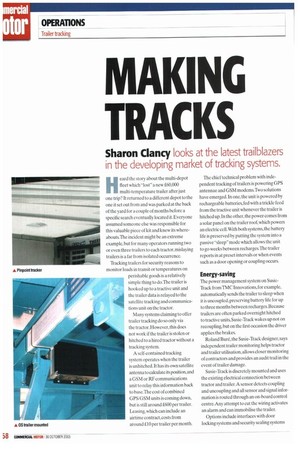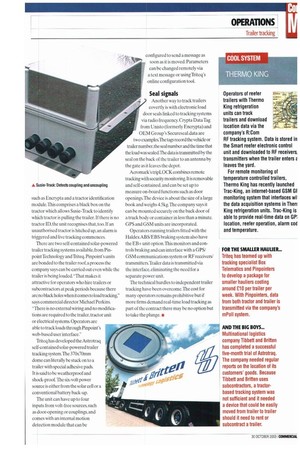MAKING TRACKS
Page 58

Page 59

If you've noticed an error in this article please click here to report it so we can fix it.
Sharon Clancy looks at the latest trailblazers in the developing market of tracking systems.
Heard the story about the multi-depot fleet which "lost" a new £60,000 multi-temperature trailer after just one trip? It returned to a different depot to the one it set out from and was parked at the back of the yard for a couple of months before a specific search eventually located it. Everyone assumed someone else was responsible for this valuable piece of kit and knew its whereabouts.The incident might be an extreme example, but for many operators running two or even three trailers to each tractor, mislaying trailers is a far from isolated occurrence.
Tracking trailers for security reasons to monitor loads in transit or temperatures on perishable goods is a relatively simple thing to do.The trailer is hooked up to a tractive unit and the trailer data is relayed to the satellite tracking and communications unit on the tractor.
Many systems claiming to offer trailer tracking do so only via the tractor. However, this does not work if the trailer is stolen or hitched to a hired tractor without a tracking system.
A self-contained tracking system operates when the trailer is unhitched. It has its own satellite antenna to calculate its position, and a GSM or RF communications unit to relay this information back to base.The cost of combined GPS/GSM units is coming down, but is still around £600 per trailer. Leasing, which can include an airtime contract,costs from around fl 0 per trailer per month. The chief technical problem with independent tracking of trailers is powering GPS antennae and GSM modems.Two solutions have emerged. In one, the unit is powered by rechargeable batteries, fed with a trickle feed from the tractive unit whenever the trailer is hitched up. In the other, the power comes from a solar panel on the trailer roof,which powers an electric cell. With both systems, the battery life is preserved by putting the system into a passive "sleep" mode which allows the unit to go weeks between recharges.The trailer reports in at preset intervals or when events such as a door opening or coupling occurs.
Energy-saving
The power management system on SusieTrack from 'TMC Innovations, for example. automatically sends the trailer to sleep when it is uncoupled. preserving battery life for up to three months between recharges. Because trailers are often parked overnight hitched to tractive units. Susie-Track wakes up not on recoupling, but on the first occasion the driver applies the brakes.
Roland Bure, the Susie-Track designer, says independent trailer monitoring helps tractor and trailer utilisation, allows closer monitoring of contractors and provides an audit trail in the event of trailer damage.
Susie-Track is discretely mounted and uses the existing electrical connection between tractor and trailer.A sensor detects coupling and uncoupling and all sensor and signal information is routed through an on-board control cent re.Any attempt to cut the wiring activates an alarm and can immobilise the trailer.
Options include interfaces with door locking systems and security sealing systems such as Encrypt a and a tractor identification module.This comprises a black box on the tractor which allows Susie-Track to identify which tractor is pulling the trailer. If there is no tractor ID, the unit recognises that, too. If an unauthorised tractor is hitched up. an alarm is triggered and live tracking commences.
There are two self-contained solar-powered trailer tracking systems available, from Pinpoint Technology and Triteq. Pinpoint's units are bonded to the trailer roof, a process the company says can be carried out even while the trailer is being loaded."That makes it attractive for operators who hire trailers or subcontractors at peak periods because there are no black holes when it comes to load tracking," says commercial director Michael Perkins. -There is no external wiring and no modifications are required to the trailer, tractor unit or electrical systems. Operators are able to track loads through Pinpoint's web-based user interface."
Triteq has developed the Astrotraq self-contained solar-powered trailer tracking system.The 370x70rnm dome can literally be stuck on to a trailer with special adhesive pads. It is said to be weatherproof and shock-proof The six-volt power source is either from the solar cell or a conventional battery back-up.
The unit can have up to four inputs from volt-free sources, such as door-opening orcouplings. and comes with an internal motion detection module that can be configured to send a message as soon as it is moved. Parameters can be changed remotely via a text message or using Triteq's online configuration tool.
Seal signals Another way to track trailers covertly is with electronic load door seals linked to tracking systems via radio frequency. Crypta Data Tag from Unisto (formerly Encrypta) and OEM Group's Secureseal.data are two examplesThe tags record the vehicle or trailer nurnber,the seal number and the time that the load was sealed.The data is transmitted by the seal on the hack of the trailer to an antenna by the gate as it leaves the depot.
Aeromark's tripLOCK combines remote tracking with security monitoring. It is removable and self-contained, and can be set up to measure on-board functions such as door openings.The device is about the size of a large book and weighs 45kg.The company says it can be mounted securely on the back door of a truck body or container in less than a minute. GPS and GSM units are incorporated.
Operators running trailers fitted with the HaldexABS/ERS braking system also have the EB+ unit option.This monitors and controls braking and can interface with a GPS/ GSM communications system or RF receivers/ transmitters.Trailer data is transmitted via the interface, eliminating the need for a separate power unit.
The technical hurdles to independent trailer tracking have been overcome.The cost for many operators remains prohibitive but if more firms demand real-time load tracking as part of the contract there may be no option but to take the plunge. •




























































































































































































